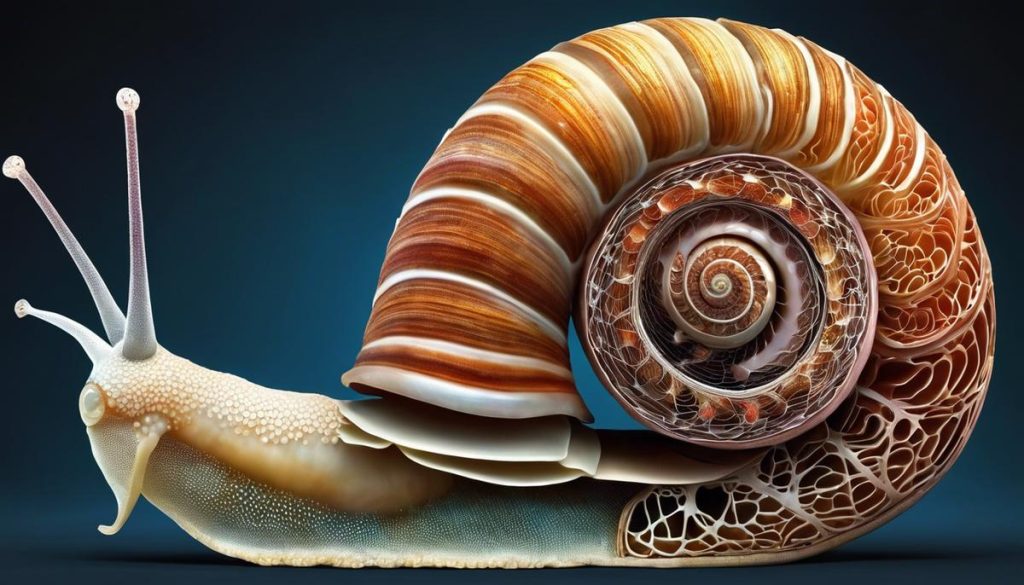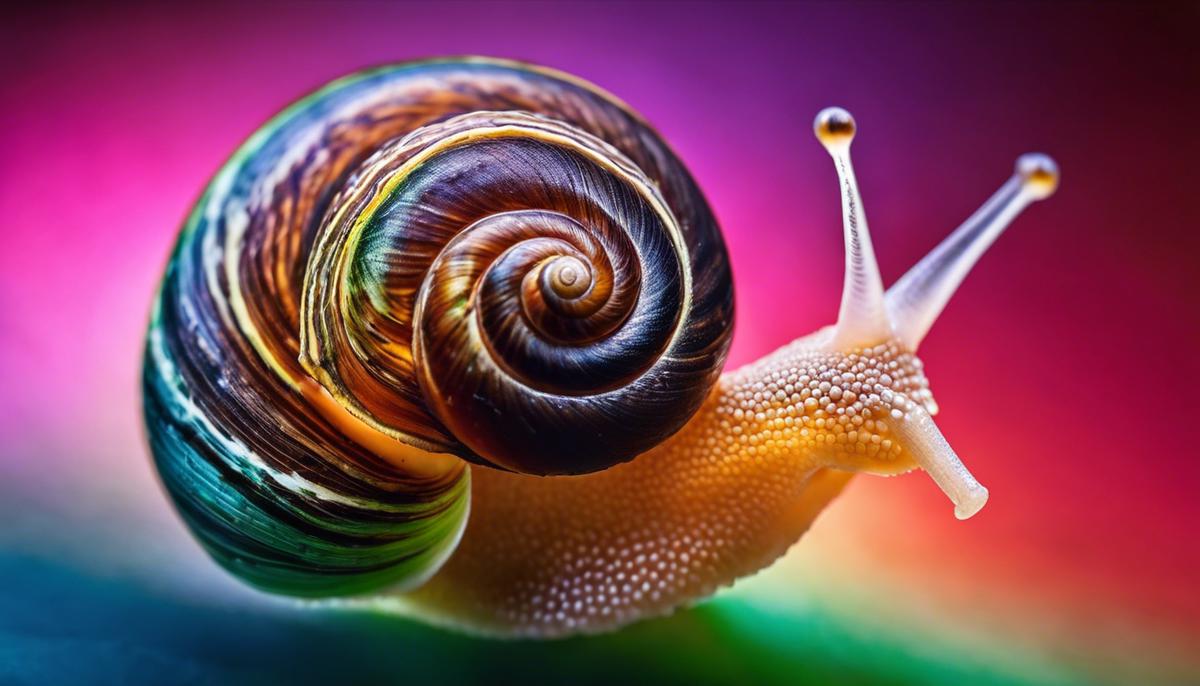Unraveling the Mystery: Can Snails Leave Their Shells?

In the vast tapestry of life on Earth, snails carve out a unique niche, shielded by their distinctive, often vibrant shells. These creatures, small and seemingly uncomplicated at first glance, are in fact remarkable examples of evolution and adaptation. Their shells, which they carry throughout their lives, are more than mere mobile homes for these gastropods. They are integral portions of their anatomy, providing protection, facilitating hydration, and acting as a vital component of their identity. Breaking down the barriers of the shell’s facade, the ensuing examination delves deep into the anatomy of a snail, its relationship with its shell, the maturation of its shell, and its evolutionary importance.
The Anatomy of a Snail
Unveiling the mysteries of nature sometimes requires us to slow down, pausing to appreciate the intricate design of seemingly simple creatures.
First, let’s explore the structure of a snail in all its complexity, and marvel at its utility and beauty. The snail, a gastropod, has a soft body and is typically enclosed in a hard shell.This shell offers a sanctuary to this soft invertebrate, acting as a mobile bunker against the environmental adversaries. A snail’s body can essentially be divided into three distinct sections – the head, foot, and visceral hump. The head comprises a pair of tentacles, bearing eyes at the tips. These are crucial sensory organs enabling the snail to navigate through its habitat. The foot, a muscular organ, flawlessly fulfills its role in locomotion and burrowing. Astoundingly, it also houses the creature’s heart and other vital organs.
However, the pièce de résistance is the intriguing visceral hump, enveloped by the snail’s shell, an intimate association that forms the cornerstone of our discussion. The snail’s shell is a monument to biological marvels, receiving inspiration and aspiration of architects and mathematicians alike. It displays a logarithmic spiral, providing an evolutionary advantage of accommodation. With this design, as the snail grows in size, so does the shell, ready to extend a roomier shelter without straying from its original shape.
This primeval blueprint nurtures the snail’s steadily enlarging visceral hump, which houses the digestive, reproductive, and respiratory systems. The shell is not merely an architectural wonder though. Indeed, the snail’s metabolic processes are attuned to its shell, reinforcing the symbiosis. Nutrition absorption, respiration, waste excretion, and even reproduction are directly or indirectly related to the shell structure.
The exterior of the shell is cast with Calcium carbonate, often recycled from a snail’s diet. This creates a formidable fortress that guards the snail from predators, harsh weather, and dehydration. Interestingly, the interior of the shell creates a humid environment, enabling the snail to execute its metabolic functions, embodying an external lung of sorts.
The interactions between the snail’s structure and its shell have evolved after relentless natural testing over millions of years. The result is an interplay of biology and physics, an elegant entwining of evolutionary biology with mathematical precision, a complexity that redefines simplicity. This distinct relationship outlines survival, resilience, and adaptability, reminding us to acknowledge and appreciate nature’s adept craftsmanship fashioned by time.

Shell Development and Evolution
Moving forward from our compelling inquiry into the intricacies of the snail’s body structure, its unique visceral hump, and the profound importance of its distinctive, logarithmically spiraled shell, we now delve deeper into the pivotal role the shell plays in the growth and the evolution of the snail.
Ascend to the scene of the snail’s early life stages, where the shell holds splendid significance. At the embryonic stage, the rudimentary shell, also known as the “protoconch,” forms. This protoconch evolves into the adult shell as the snail matures, embodying both growth and evolution in a tangible form.
Essentially, as the snail grows, new material for the shell is secreted by the mantle, the specialized tissue layer that envelops the visceral hump. The mantle’s glandular cells excrete calcium carbonate, mixed with a protein called conchiolin, which hardens to form the shell’s protectively robust and beautiful spiral. The process of growth mimics an architect meticulously working, accumulating each layer over time, until the exterior results in a marvelous testament to intricate design.
Beyond merely offering physical protection, the shell is vastly implicated in the snail’s daily existence, particularly its physiological processes. It serves as an aid in respiration, where the water-laden mucous layer beneath the shell aids in the diffusion of oxygen, thereby facilitating efficient gas exchange, likened to an unconventional pair of lungs.
Moreover, the shell forms an integral defensive feature against predation and adverse environmental conditions. Its remarkably hard and spiral design not only wards off potential predators but also allows for the retraction of the snail’s soft body parts into its robust, protective shell during unfavorable circumstances.
Interestingly, the shell also plays a significant role in the sexual dimorphism of certain snail species. For instance, in the left-coiled (sinistral) marine snail, the shell proves pivotal in facilitating reproductive alignment.
In terms of evolution, the remarkable variation in shell traits – size, thickness, pattern, and coloration – across different snail species attest to the natural selection pressures impacting their survival and reproductive success. In essence, the shell’s structural and functional adaptations correspond to the snail’s given habitat, predation threats, and climatic conditions.
The shell not only bears witness to the growth and evolution of a snail but also actively orchestrates these processes. It serves as a fortress, a respiratory aid, a determinant of reproductive success, and a vibrant canvas of evolutionary adaptations. Its importance is not merely ornamental but integral to the fascinating saga of snail survival and evolution.

Physiology and Behavior of Snails Related to their Shells
Delving into the embryonic stages of a snail, we encounter a crucial period during which the formation of the protoconch, the first whorl or embryonic shell, takes place. This small, spirally coiled structure is formed within the developing egg and is the incipient reflection of the snail’s future home. The protoconch embodies the harmonious interplay between the snail and its shell from the onset.
A key role player in the shell’s growth is the mantle, the specialized tissue enveloping the snail’s visceral hump. As the snail matures, the mantle secretes new layers of calcium carbonate, alongside conchiolin, a protein imparting resilience to the shell and aiding in the formation of the shell’s outer layer, the periostracum. This intricate secretory process enables the shell to expand and thicken, mirroring the snail’s growth.
Furthermore, the snail’s shell also plays an instrumental role in respiration and gas exchange. In land snails, a highly vascular region of the mantle functions as a rudimentary lung, exchanging gases through an opening, the pneumostome. The symbiosis of the mantle and the shell, therefore, not only involves mechanical structure growth but also extends to the critical life process of respiration.
Snails, due to their slow-moving nature, are an easy target for predators. Hence, evolution imbued them with a robust shell as self-defence. Retracting into their shell when threatened, the snail’s shell functions as a protective fortress against predators and adverse environmental conditions such as desiccation or low temperatures. Evolution, in this aspect, has masterfully combined architecture principles with biology to ensure the survival of snails.
The shell also plays a role in sexual dimorphism among certain snail species, where males and females display distinct shell morphology. This highlights another intricate interaction where the adaptive evolution of the shell caters to reproductive strategies, aiding in sex identification.
Furthermore, it is worth noting the variation in shell traits across various snail species, revealing the fingerprints of natural selection. Modifications in shell shape, size, and pattern reveal how these mollusks have adapted to diverse ecological settings, showcasing once again the intricate co-evolutionary process between the snail and its shell.
The shell plays a central role in the life and evolution of a snail, acting as a physical barrier, a gas exchange terminal, a growth tracker, and even as a sex symbol. Ultimately, a snail’s shell is not just a simple protective cover but an emblem of evolution, tailored to perfection.

The journey through the fine structure and life of a snail and its shell serves as a remarkable showcase of nature’s grand design. From understanding the complex integration of the shell within the snail’s body, through the exploration of its growth and evolution, to the behavioral patterns manifesting their dependence on this calcium fortress, one can gain a deepened appreciation for these often overlooked creatures. Studying snails and their shells highlights an important lesson; seemingly simple organisms frequently harbor an incredible complexity. It reaffirms the fact that every creature, as insignificant as it may appear, holds its place in the grandeur scheme of life, contributing in ways that often go unnoticed. Recapitulating from the microscopic luminescent sheets of nacre intricately bonded within the shell, up to the macro level of their survival strategies, the grand narrative of snails and their shells echoes that each aspect of life entwines into a beautiful, nearly incomprehensible web of existence.